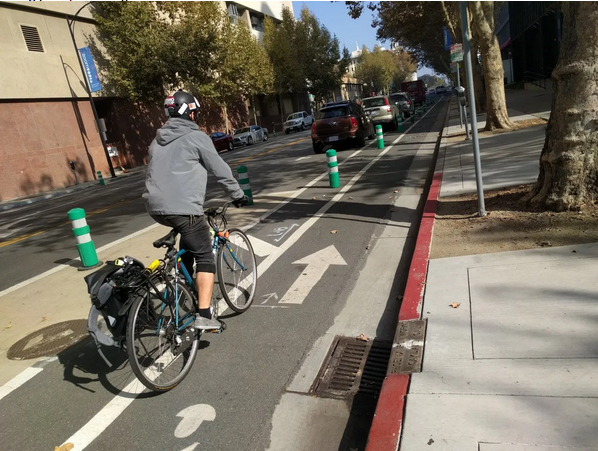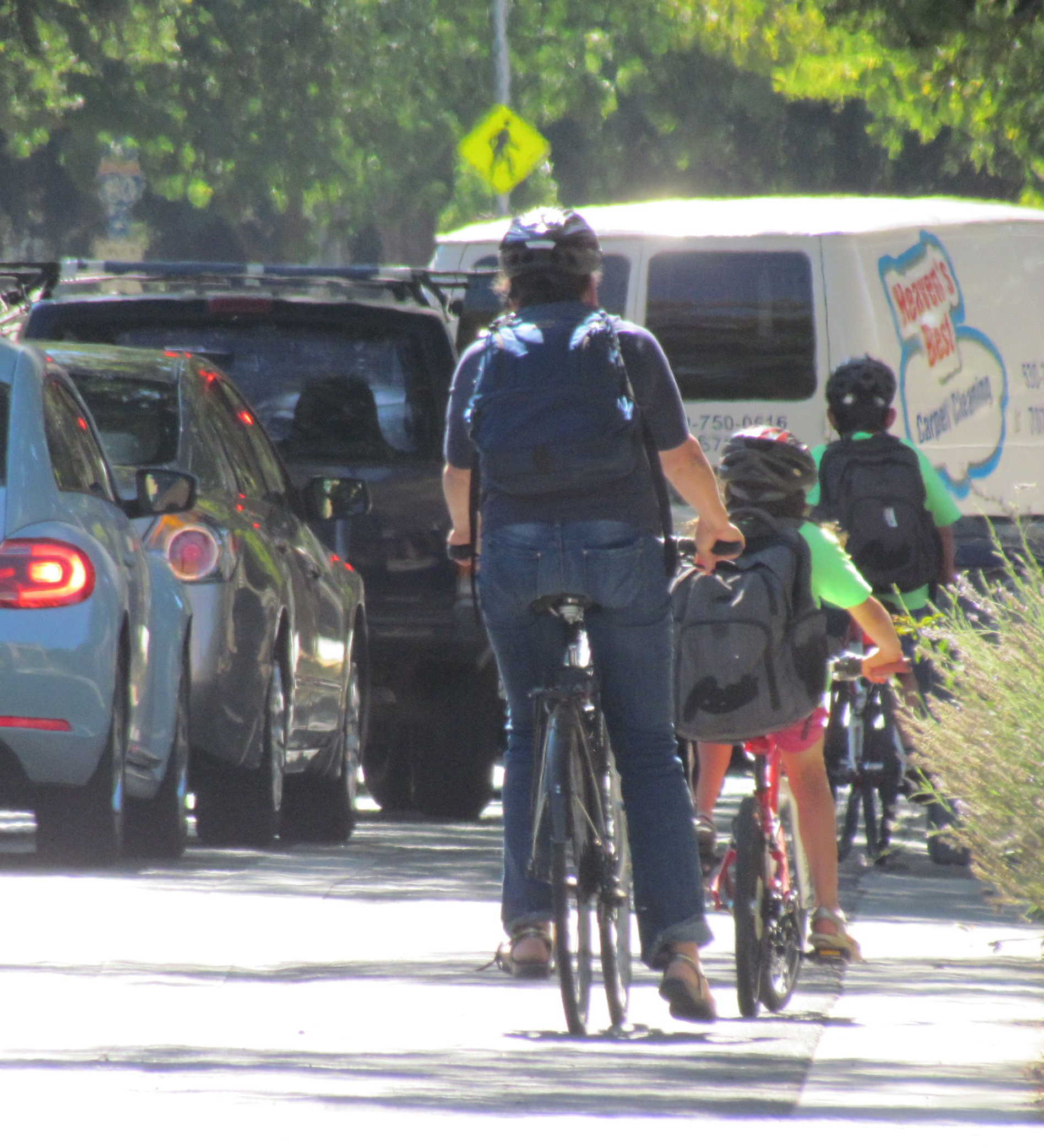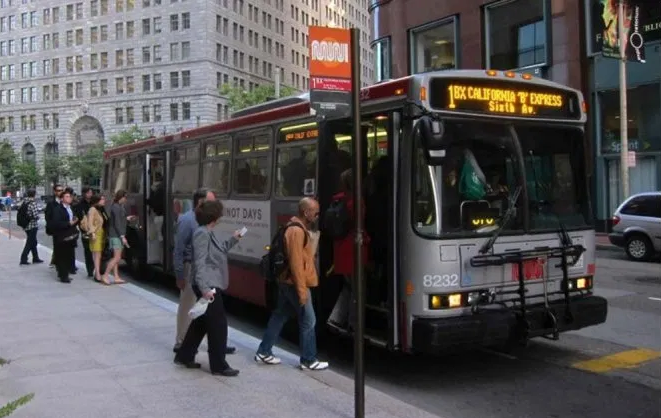Note: GJEL Accident Attorneys regularly sponsors coverage on Streetsblog San Francisco and Streetsblog California. Unless noted in the story, GJEL Accident Attorneys is not consulted for the content or editorial direction of the sponsored content.
Staff at the California Transportation Commission are in the final stages of preparing draft guidelines for the next round of funding for the Active Transportation Program. They expect the guidelines update to be adopted at the next CTC meeting on March 25, and a call for projects to go out soon thereafter.
Staff has kept the number of changes as low as possible so that applicants to the highly competitive program don't have to relearn new procedures with each funding cycle. But there is one potential change that could lead to bigger changes in the future: for Cycle 5, staff are considering adding a pilot program to encourage "quick-build" projects.
Quick-Build: Cheap, Fast, Flexible
Quick-build projects make relatively inexpensive changes to existing rights-of-way to quickly fix safety issues and allow people to test out street designs. They give drivers, walkers, bicyclists, wheelchairists, and everybody else the opportunity to immediately experience how a street design change affects them. Quick-build projects allow cities to continuously gather feedback from the community, collect safety data, and make adjustments without committing to a permanent, expensive streetscape redesign.
Quick-build has been used successfully in several cities in California, including San Jose and San Francisco, to mostly good results. If something doesn't work, it can be changed or removed. Even if something does work, loud political opposition can cause it to be removed without great expense. And if the design proves to increase safety or livability or encourage more walking and biking, funding can be then be pursued for a more permanent streetscape, while the community gets to enjoy the traffic calming benefits already in place.
But quick-build doesn't easily fit into the state's funding processes. Projects are normally planned and discussed for years, and even if they are awarded funding the first time they apply, the money can take years to arrive. Any changes or adjustments are subject to a time-consuming and complex "scope-change" process involving layers of approvals that can take many months if not longer.
CTC staff "didn't know a lot about quick-build," Laurie Waters, CTC's lead ATP staffmember, told Streetsblog--until they traveled to San Jose for a workshop there. "We were amazed at what they were doing; it was really effective," she said. The city was "able to identify issues with the project before investing millions of dollars into permanent infrastructure. Once we saw them, we thought: why isn't everybody doing this? Particularly if you have to take a lane or parking, where they might get a lot of resistance; once people see it, they might not object so strenuously."
"Another difference with quick-build is the need to do outreach constantly, to check in with how it's going, to see whether they need to adjust," she said. "San Francisco has been really good at doing an ongoing evaluation process."
CTC staff are currently working out how best to incorporate quick-build projects into the existing structure of the Active Transportation Program. Currently the idea is to set aside $7 million as a pilot program in the next funding cycle starting in April. Applications for that cycle will be due in mid-June.
It's not a lot of money. The entire funding cycle will award around $450 million for projects in statewide, regional, and small urban and rural categories. The $7 million will not use any federal funding, and will come off the top of the statewide projects category, which is expected to award around $223 million.
"We're hoping to fund at least a couple [of quick-build projects] in different parts of the state, via a simplified application process," said Waters. "We're doing it as a pilot program so we can identify issues with the processes before we make them permanently eligible for funding."
It's not entirely clear what a successful application will need at this point. For example, some kind of environmental clearance is necessary, and the process for modifying designs on the fly still needs to be worked out. But bottom line: "We want them to be successful," said Waters.
Recommendations From ATP Workshops: Context, Data
CTC staff has been holding workshops throughout the state both to gather feedback on the draft guidelines and to visit and learn from places that have had less success in past funding cycles. Sometimes the areas are in far-flung small cities or rural areas that have few staff to develop projects and work on applications; sometimes they are areas with a lot of need but where planners may be only vaguely aware of the ATP.
Waters said most of the workshop attendees are planners who want to learn about funding opportunities or are planning to apply and want to improve their chances of success. "I wish there were more advocates" at these workshops, she said, because they have knowledge of needs and shortcomings that could help inform the program's shape.
Applicants sometimes have a hard time clearly explaining those needs. For example, coastal cities are sometimes seen as vacation areas, with needs limited to recreational activities, but their residents also need to get around safely on foot and by bike. That doesn't always come across in the applications.
Some communities may know they need better sidewalks around a school, for example, so they submit an application for a Safe Routes to Schools project. "But when you talk to them you find the school is the center for every single thing in the community," said Waters. "They use it for public meetings, get-togethers, community events--everything happens in that school. So it's not just kids, it's everybody who's walking to the school."
"They need to think beyond their initial impression of the project," she added. "When you live in an area, it can be hard to see these things," she said. But it's key that the entire context comes across clearly to people evaluating the application--who may never have visited the area.
At the workshops, staff have also discussed the data that applications need to include to back up their assessments. While police-generated collision data from SWITRS is accepted, it has limitations, including a slow lead time and sparse data. CTC staff encourages using data from third-party apps as well--things like StreetStory from UC Berkeley's SafeTREC, or OurStreets, for example. Both apps collect and map information about crashes, near-misses, speeding, aggressive driving, blocked lanes--data points that are not likely to show up on an official police crash map.
Advocates can play a role in getting the word out to communities about these apps, and encouraging people to report problems they experience on their streets.
More Money Needed
It's also important to note that the ATP has been encouraging, and seeing, an increase in applications for large, expensive projects that can have a transformative effect on a wide area. However, these use up a bigger piece of the ATP pie. And the Active Transportation Program itself is a tiny slice of the overall state transportation budget.
If the ATP were to get a significant, ongoing allocation from cap-and-trade--a topic for another post, or many posts--it could fund those very large project requests without giving up the small and medium projects that can make a huge difference in smaller urban and rural areas.
The program got a one-time allocation from the Greenhouse Gas Reduction Fund of $10 million, but that four years ago, when cities were just learning about the program, applications were less sophisticated, and proposed projects tended to be smaller. It was harder to show sizable greenhouse gas reductions from those smaller, unconnected projects. Now, cities and regions are considering larger projects that form more of a connected network, and those can show greater GHG reductions, making them good potential GGRF investments.
Two more workshops are scheduled before the CTC meeting to adopt the guidelines: On March 10 in San Diego, and on March 11 in Orange. More information, including materials from numerous past workshops, can be found here, under the "Cycle 5" tab.





